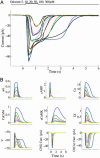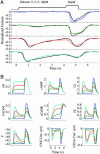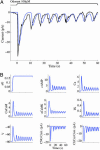Computational model of the cAMP-mediated sensory response and calcium-dependent adaptation in vertebrate olfactory receptor neurons
- PMID: 16027364
- PMCID: PMC1180786
- DOI: 10.1073/pnas.0504099102
Computational model of the cAMP-mediated sensory response and calcium-dependent adaptation in vertebrate olfactory receptor neurons
Abstract
We develop a mechanistic mathematical model of the G-protein coupled signaling pathway responsible for generating current responses in frog olfactory receptor neurons. The model incorporates descriptions of ligand-receptor interaction, intracellular transduction events involving the second messenger cAMP, effector ion-channel activity, and calcium-mediated feedback steps. We parameterized the model with respect to suction pipette current recordings from single cells stimulated with multiple odor concentrations. The proposed model accurately predicts the receptor-current response of the neuron to brief and prolonged odorant exposure and is able to produce the adaptation observed under repeated or sustained stimulation.
Figures



Similar articles
-
Mechanism of odorant adaptation in the olfactory receptor cell.Nature. 1997 Feb 20;385(6618):725-9. doi: 10.1038/385725a0. Nature. 1997. PMID: 9034189
-
Olfactory adaptation. The nose leads the eye.Nature. 1997 Feb 20;385(6618):677, 679. doi: 10.1038/385677a0. Nature. 1997. PMID: 9034182 No abstract available.
-
Cellular and molecular constituents of olfactory sensation in vertebrates.Comp Biochem Physiol A Mol Integr Physiol. 2000 May;126(1):17-32. doi: 10.1016/s1095-6433(00)00191-4. Comp Biochem Physiol A Mol Integr Physiol. 2000. PMID: 10908849 Review.
-
Odor discrimination by G protein-coupled olfactory receptors.Microsc Res Tech. 2002 Aug 1;58(3):135-41. doi: 10.1002/jemt.10131. Microsc Res Tech. 2002. PMID: 12203691 Review.
-
Phosphorylation of voltage-gated ion channels in rat olfactory receptor neurons.Eur J Neurosci. 2001 Oct;14(7):1056-64. doi: 10.1046/j.0953-816x.2001.01722.x. Eur J Neurosci. 2001. PMID: 11683897
Cited by
-
A molecular odorant transduction model and the complexity of spatio-temporal encoding in the Drosophila antenna.PLoS Comput Biol. 2020 Apr 14;16(4):e1007751. doi: 10.1371/journal.pcbi.1007751. eCollection 2020 Apr. PLoS Comput Biol. 2020. PMID: 32287275 Free PMC article.
-
Computational model of the insect pheromone transduction cascade.PLoS Comput Biol. 2009 Mar;5(3):e1000321. doi: 10.1371/journal.pcbi.1000321. Epub 2009 Mar 20. PLoS Comput Biol. 2009. PMID: 19300479 Free PMC article.
-
What is the core oscillator in the speract-activated pathway of the Strongylocentrotus purpuratus sperm flagellum?Biophys J. 2012 Jun 6;102(11):2481-8. doi: 10.1016/j.bpj.2012.03.075. Epub 2012 Jun 5. Biophys J. 2012. PMID: 22713563 Free PMC article.
-
Mathematical modeling of calcium signaling during sperm hyperactivation.Mol Hum Reprod. 2011 Aug;17(8):500-10. doi: 10.1093/molehr/gar040. Epub 2011 May 23. Mol Hum Reprod. 2011. PMID: 21606121 Free PMC article. Review.
-
Mechanisms of regulation of olfactory transduction and adaptation in the olfactory cilium.PLoS One. 2014 Aug 21;9(8):e105531. doi: 10.1371/journal.pone.0105531. eCollection 2014. PLoS One. 2014. PMID: 25144232 Free PMC article.
References
Publication types
MeSH terms
Substances
Grants and funding
LinkOut - more resources
Full Text Sources
Other Literature Sources
Molecular Biology Databases

